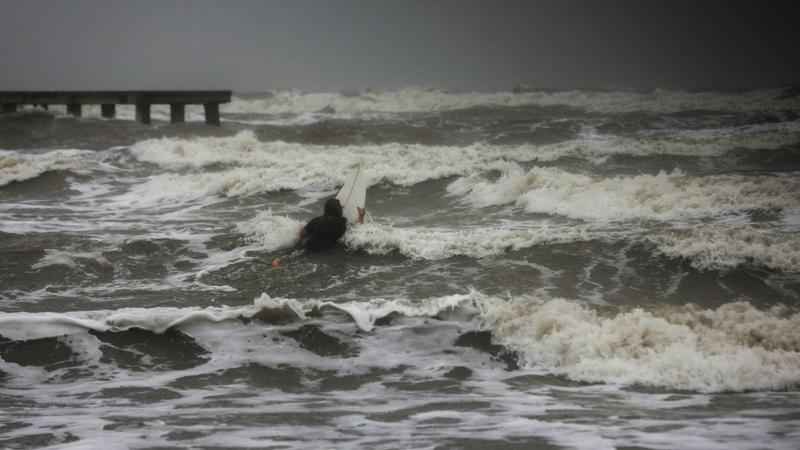Nicholas, now tropical storm, dumps rain along Gulf Coast

A surfer tries to paddle through the surf as wind and rain from Tropical Storm Nicholas batters the area Monday, Sept. 13, 2021, along the seawall in Galveston, Texas.[Jon Shapley/Houston Chronicle]
Tropical Storm Nicholas hit the Texas coast early Tuesday as a hurricane and dumped more than a foot (30.5 centimeters) of rain along the the same area swamped by Hurricane Harvey in 2017, drenching storm-battered Louisiana and bringing the potential for life-threatening flash floods across the Deep South.
Nicholas made landfall on the eastern part of the Matagorda Peninsula and was soon downgraded to a tropical storm. It was about 30 miles (50 kilometers) south-southwest of Houston, Texas, with maximum winds of 70 mph (110 kph) as of 4 a.m. CDT Tuesday, according to the National Hurricane Center in Miami. Nicholas was the 14th named storm of the 2021 Atlantic hurricane season.
The storm was moving north-northeast at 9 mph (15 kph) and the center of Nicholas was expected to move slowly over southeastern Texas on Tuesday and over southwestern Louisiana on Wednesday.
Galveston has received nearly 14 inches (35 centimeters) of rain with the storm while the flood-prone Houston area saw more than 6 inches (15 centimeters) of rain, according to preliminary reports from the National Weather Service. Nicholas could dump up to 20 inches (51 centimeters) of rain in parts of central and southern Louisiana.
Nearly all of the coastline in Texas was under a tropical storm warning that included potential flash floods and urban flooding. Texas Gov. Greg Abbott said authorities placed rescue teams and resources in the Houston area and along the coast.
In Houston, officials worried that heavy rain could inundate streets and flood homes. Authorities deployed high-water rescue vehicles throughout the city and erected barricades at more than 40 locations that tend to flood, Mayor Sylvester Turner said Monday.
“This city is very resilient. We know what we need to do. We know about preparing,” said Turner, referencing four major flood events that have hit the Houston area in recent years, including devastating damage from Harvey.
Meteorologist Kent Prochazka of the National Weather Service told The Associated Press early Tuesday that Nicholas’ winds downed trees in coastal counties and caused some gas stations to lose awnings.
“Right before it made landfall, it abruptly intensified into a hurricane and as it moved inland, the pressures began to rise with it. The winds have relaxed slightly and now we’re getting down into tropical storm force (winds),” he said.
CenterPoint Energy reported that over 300,000 customers lost power as the storm rolled through Houston and that it expected those numbers to rise.
Numerous school districts along the Texas Gulf Coast canceled classes Monday because of the incoming storm. The Houston school district, the state’s largest, as well as others, announced that classes would be canceled on Tuesday. The weather threat also closed multiple COVID-19 testing and vaccination sites in the Houston and Corpus Christi areas and forced the cancellation of a Harry Styles concert scheduled for Monday evening in Houston.
Six to 12 inches (15 to 30 centimeters) of rain were expected along the middle and upper Texas coast, with isolated maximum amounts of 18 inches (46 centimeters) possible. Other parts of southeast Texas and south-central Louisiana and southern Mississippi could see 4 to 8 inches (10 to 20 centimeters) over the coming days.
A tornado or two may be possible Tuesday along the upper Texas and southwest Louisiana coast, according to the weather service.
“Listen to local weather alerts and heed local advisories about the right and safe thing to do, and you’ll make it through this storm just like you’ve had many other storms,” Abbott said during a news conference in Houston.
Nicholas brought rain to the same area of Texas that was hit hard by Harvey. That storm made landfall in the middle Texas coast then stalled for four days, dropping more than 60 inches (152 cm) of rain in parts of southeast Texas. Harvey was blamed for at least 68 deaths, including 36 in the Houston area.
After Harvey, voters approved the issuance of $2.5 billion in bonds to fund flood-control projects, including the widening of bayous. The 181 projects designed to mitigate damage from future storms are at different stages of completion.
But University of Miami hurricane researcher Brian McNoldy said he expects that Nicholas “will be magnitudes less than Harvey in every regard.”
The worry with Nicholas will be how slowly it moves. Storms are moving slower in recent decades, and Nicholas could get stuck between two other weather systems, said hurricane researcher Jim Kossin of The Climate Service.
Louisiana Gov. John Bel Edwards declared a state of emergency Sunday night, ahead of the storm’s arrival in a state still recovering from Hurricane Ida and last year’s Hurricane Laura and historic flooding.
“The most severe threat to Louisiana is in the southwest portion of the state, where recovery from Hurricane Laura and the May flooding is ongoing,” Edwards said.
The storm was expected to bring the heaviest rainfall west of where Ida slammed into Louisiana two weeks ago. Ida has been blamed for 86 deaths throughout the United States. Across Louisiana, about 95,000 customers remained without power Tuesday morning, according to the utility tracking site poweroutage.us.
Colorado State University hurricane researcher Phil Klotzbach said via Twitter that only four other years since 1966 have had 14 or more named storms by Sept. 12: 2005, 2011, 2012 and 2020.